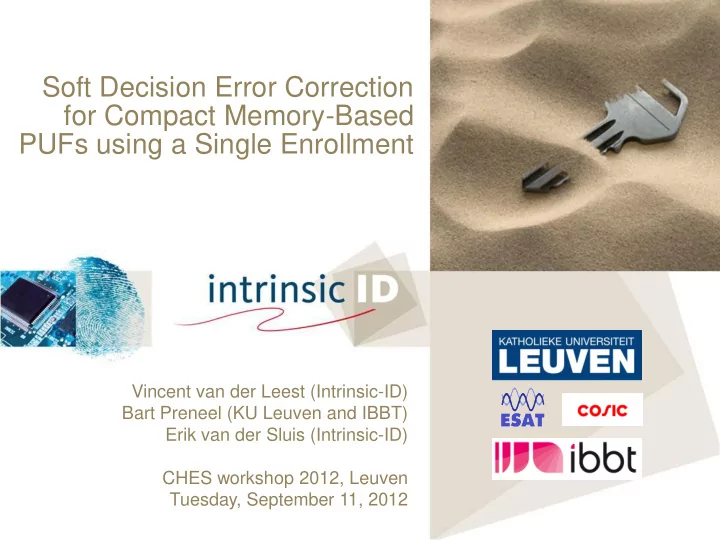

Soft Decision Error Correction for Compact Memory-Based PUFs using a Single Enrollment Vincent van der Leest (Intrinsic-ID) Bart Preneel (KU Leuven and IBBT) Erik van der Sluis (Intrinsic-ID) CHES workshop 2012, Leuven Tuesday, September 11, 2012
Introduction • PUFs – IC identification based on physical characteristics – Measurements are noisy and require error correction • Use Case: Secure Key Storage – Error correct noisy PUF to produce stable key • Error correction – Overhead on PUF size, efficient codes are required – Soft decision decoding is more efficient than hard decision – Soft decision algorithms with multiple measurements exist – We introduce soft decision using a single measurement Confidential Tuesday, September 11, 2012 2
Memory-based PUFs • Memory-based PUFs: deriving PUF fingerprint from start-up pattern of (standard-cell) memory in IC • Examples: SRAM, D Flip-Flop, Latch, Buskeeper … • Startup patterns are required to be: – Robust (stable under different operating conditions) – Unique (random and unpredictable) • Memory-based PUF used here: SRAM PUF Confidential Tuesday, September 11, 2012 3
Use Case: Secure key storage In secure environment: - “Program” key - Derive helper data - Store helper data During operation: - Retrieve secret key using helper data and PUF response - Secret reproducible with error correction Confidential Tuesday, September 11, 2012 4
Soft decision decoding: state of the art • Soft decision decoding for memory-based PUFs*: – Enrollment: • Perform multiple measurements • Derive error probability of each PUF bit • Store error probability with helper data (= soft information) – Reconstruction: • Use error probabilities as confidence level for each bit • Less PUF bits required to reconstruct secret * [Maes-Tuyls-Verbauwhede'09] Confidential Tuesday, September 11, 2012 5
Motivation for new construction • Using multiple enrollment measurements leads to: – Requiring non-volatile memory during enrollment – Growing footprint with number of measurements – Additional enrollment time in production line • Drawbacks make soft decision decoding for PUFs practically and commercially inapplicable Confidential Tuesday, September 11, 2012 6
Our proposal (high level) • Hard decision decoding using concatenated codes* Encoding Linear Repetition (enrollment) Encoder Encoder Decoding Linear Repetition (reconstruction) Decoder Decoder * [Bösch-Guajardo-Sadeghi-Shokrollahi- Tuyls’08 ] Confidential Tuesday, September 11, 2012 7
Our proposal (high level) • Soft decision decoding using concatenated codes Encoding Linear Repetition (enrollment) Encoder Encoder Decoding Linear Soft Repetition (reconstruction) Quantizer Decoder Decoder Decoder • Quantizer: only a single enrollment measurement required Confidential Tuesday, September 11, 2012 8
Soft decoder examples • Decoders with efficient hardware implementation • Brute force decoder: – Codes with limited set of codewords – Calculate Euclidean Distance input to all codewords – Select most likely codeword for decoding – Examples: Reed-Muller [16,5,8] and [8,4,4] • Hackett decoder: – Golay [24,12,8] decoder with soft input – Hard decision decoding with 8 different input patterns – Input patterns selected based on soft information – Most likely output selected based on Euclidean Distance Confidential Tuesday, September 11, 2012 9
Calculating hard decision performance Hard decision FRR can be calculated based on length of repetition code (equations available for concatenated codes) Based on results, codes require repetition length: RM[16,5,8] : 13 bits RM[8,4,4] : 23 bits Golay[24,12,8] : 13 bits Confidential Tuesday, September 11, 2012 10
Simulating soft decision performance No equations available for calculating FRR of soft decision codes simulations performed Based on simulations, codes require repetition/ quantizer length: RM[16,5,8] : 7 bits RM[8,4,4] : 14 bits Golay[24,12,8] : 8 bits Confidential Tuesday, September 11, 2012 11
Comparing amount of SRAM required Code Type Repetition length FRR SRAM (bytes) 1.6 · 10 -7 RM[16,5,8] Hard 13 910 3.7 · 10 -7 RM[16,5,8] Soft 7 490 3.4 · 10 -7 RM[8,4,4] Hard 25 1075 3.3 · 10 -7 RM[8,4,4] Soft 14 602 4.0 · 10 -7 Golay[24,12,8] Hard 13 585 4.8 · 10 -7 Golay[24,12,8] Soft 8 360 Results show: soft decision decoding decreases amount of SRAM required 38 - 47% in these examples Confidential Tuesday, September 11, 2012 12
Comparing total footprint Impact of SRAM SRAM 10 changes with: 9 Footprint (kGE) 8 Soft/Linear • FRR 7 decoder 6 • Noise rate 5 • Key length 4 Quantizer/ 3 Repetition • Number of keys 2 decoder 1 • … Encoder 0 In this example: SRAM cell ≈ 1GE Confidential Tuesday, September 11, 2012 13
Conclusions • New soft decoding method for memory-based PUFs : – Using only single enrollment measurement – Requires 38 - 47% less PUF bits than hard decoding – Solves issues from old method (NVM, footprint, enrollment time) – All example codes implemented efficiently in hardware • New method comes at a limited cost in resources • Size of PUF more dominant in footprint cost decreases • Decoder implementation to be chosen based on: – What to minimize: PUF size, footprint, … – Values of FRR, noise rate, key length, number of keys, … Confidential Tuesday, September 11, 2012 14
Questions? Confidential Tuesday, September 11, 2012 15
Recommend
More recommend